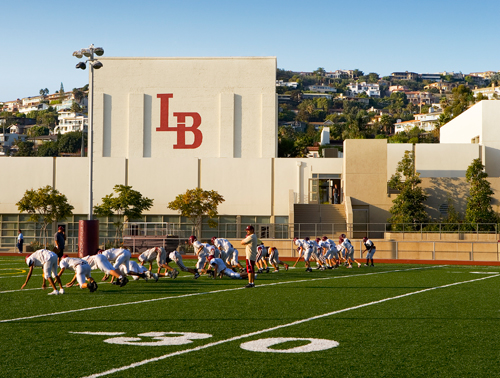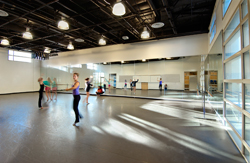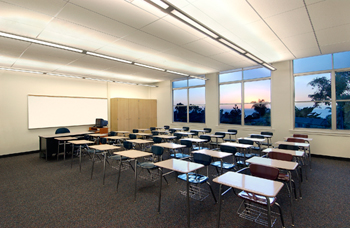Green Modernization Part 1: How a Messy Path Can Lead to Clean Green
Thu, Oct 22, 2009 Albert Lam Adaptive Reuse, Albert Lam, K-12 Schools, Green Modernization, Energy Efficiency
 For a new technical designer in K-12 schools, working on a modernization isn't exactly the most glamorous job. Having spent multiple years in school developing projects featuring fresh sites with unlimited possibilities, young designers often find it quite alien to work on "mods" and reconcile issues such as coordinating as-built drawings with actual construction, upgrading facilities to meet the latest code, and integrating new design into complicated existing structures. In contrast to the blank canvases of new construction, mods require careful survey of current conditions, even more stringent communication with the client to pinpoint desired improvements, and the patience to deal with the inevitable surprises that come from uncovering what has actually been built (or in some cases, not built!).
For a new technical designer in K-12 schools, working on a modernization isn't exactly the most glamorous job. Having spent multiple years in school developing projects featuring fresh sites with unlimited possibilities, young designers often find it quite alien to work on "mods" and reconcile issues such as coordinating as-built drawings with actual construction, upgrading facilities to meet the latest code, and integrating new design into complicated existing structures. In contrast to the blank canvases of new construction, mods require careful survey of current conditions, even more stringent communication with the client to pinpoint desired improvements, and the patience to deal with the inevitable surprises that come from uncovering what has actually been built (or in some cases, not built!).
Besides, these are old and icky buildings that seem hopelessly outdated and unsalvageable--both from a design and building code standpoint-- wouldn't it be easier to just knock everything down and start anew? Save the headaches!
It's a tempting thought, and one I've certainly been guilty of entertaining on many instances, but ultimately, I cannot help but recognize that modernizations are often the most sustainable and economical ways to improve a client's facilities. They provide an excellent opportunity to upgrade existing building systems without requiring brand new infrastructure, and they can revitalize a campus in the same way new construction can--without exhausting the same amount of resources or energy. They give existing buildings and sites the opportunity to become more environmentally friendly.
Take mechanical systems. All mechanical units have a limited shelf life, but many aging schools rely on decades-old technology that is inefficient and harmful to the atmosphere. Part of a mod's scope may involve installing units that do not emit chlorofluorocarbons and run off zoned systems that dynamically integrate with mixed ventilation within each room. These systems can monitor ambient conditions and run only when needed, instead of heating and cooling endlessly throughout the day, even when internal temperature is comfortable. Such an upgrade, though possibly more expensive up front compared to sticking with the same technology, will certainly provide significant energy savings through the system's life cycle. Similarly, with plumbing, high-efficiency fixtures such as low-flo urinals and automatic faucets can drastically reduce water consumption. Campus landscape beatification can employ drought tolerant and low-irrigation planting, further lowering water demands. Given the increasingly fragile state of water utilities these days, these gestures will continue to save money as water demand continues to rise and water supply dwindles. Then there is the healing power of architecture, which can mend years of rag-tag additions and re-unify a campus into one consistent aesthetic--all while improving building sustainability and performance. Installing low-e glazing can reduce heating loads, replacing building materials and provide renewed durability, and using new wall, floor, and ceiling finishes can enhance indoor air quality and reinvigorate the interior environment. A progressive approach toward daylighting can lower lighting demands and produce a friendlier learning atmosphere. And classroom upgrades can improve acoustics, honing speech intelligibility to refine the quality of teaching and verbal interactivity.
Then there is the healing power of architecture, which can mend years of rag-tag additions and re-unify a campus into one consistent aesthetic--all while improving building sustainability and performance. Installing low-e glazing can reduce heating loads, replacing building materials and provide renewed durability, and using new wall, floor, and ceiling finishes can enhance indoor air quality and reinvigorate the interior environment. A progressive approach toward daylighting can lower lighting demands and produce a friendlier learning atmosphere. And classroom upgrades can improve acoustics, honing speech intelligibility to refine the quality of teaching and verbal interactivity. All of this, when executed under the confines of a modernization, provide the same results as new construction at a substantial savings, because no one has to worry about setting up brand new utilities, extensive groundwork, or erecting structural elements. Those are several major steps in the construction process the school does not have to finance. And the final result can look just as stunning as if everything had been assembled from scratch. Just look at Laguna Beach High School or Valley Christian High School.
All of this, when executed under the confines of a modernization, provide the same results as new construction at a substantial savings, because no one has to worry about setting up brand new utilities, extensive groundwork, or erecting structural elements. Those are several major steps in the construction process the school does not have to finance. And the final result can look just as stunning as if everything had been assembled from scratch. Just look at Laguna Beach High School or Valley Christian High School.
So it makes logical sense to encourage modernizations over brand new construction whenever possible, even though the work involved may often be more complicated and stressful. Modernizations are necessities that every school will encounter at some point in their histories, and they are basically a form of adaptive reuse (or same-use), a hot buzzword in green design these days. Ultimately, however, the biggest payoff is seeing the joy in students' faces when they see their revitalized campus, fresh and new again. The pride and excitement the final product brings is well worth the long, often-messy journey to get there.
Albert Lam is a Project Coordinator at California-based LPA Inc. He is a LEED accredited professional who specializes in the design and implementation of K-12 schools.